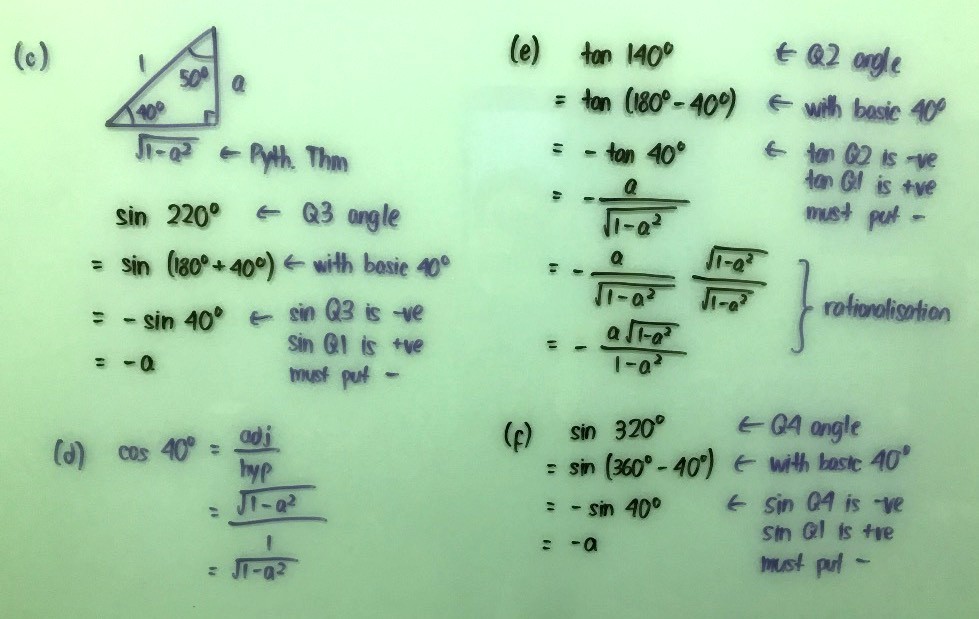Ask Singapore Homework?
Upload a photo of a Singapore homework and someone will email you the solution for free.

See 4 Answers
done
{{ upvoteCount }} Upvotes
clear
{{ downvoteCount * -1 }} Downvotes
Part a
Date Posted:
3 years ago
thx :)
done
{{ upvoteCount }} Upvotes
clear
{{ downvoteCount * -1 }} Downvotes
Part b
Date Posted:
3 years ago
for this part why did tan(-50) become tan50 in the diagram and the first part tho
btw for the tan(360-50) part its just ddloing the basic and main angle rule right? as the angle is at the fourth quad we use (360- negative angle
btw for the tan(360-50) part its just ddloing the basic and main angle rule right? as the angle is at the fourth quad we use (360- negative angle
i dont really understand the part on when to use - ve and +ve sign tho
The Tan 50 we take from the diagram.
For Tan (-50), you have to determine its basic angle and how it is related to Tan 50, but ultimately we must make reference to Tan 50.
For Tan (-50), you have to determine its basic angle and how it is related to Tan 50, but ultimately we must make reference to Tan 50.
For the -ve and +ve, we just have to see whether the sin, cos or Tan of our angle is positive or negative (first quadrant is the only quadrant in which all three are positive).
Because tan (4th quad angle) is a negative value and Tan (1st quad angle) is a positive value, they have opposite signages. So, we must include a - sign to factor this
ie
Tan (360 - x) = -Tan x
just like
Tan (180 - x) = - Tan x
Because tan (4th quad angle) is a negative value and Tan (1st quad angle) is a positive value, they have opposite signages. So, we must include a - sign to factor this
ie
Tan (360 - x) = -Tan x
just like
Tan (180 - x) = - Tan x
That diagram which I used, I didn’t erase it from the first part at all. It’s meant to be the same triangle for referencing purposes for the entire question. I put it there on every page so that you do not have to refer back to the first page every time.
sry i still dont really understand this part, can you explain to me again? will really appreciate it :)
Ok, remind me later
I look at my student's work now, then this question
done
{{ upvoteCount }} Upvotes
clear
{{ downvoteCount * -1 }} Downvotes
The other four parts
Date Posted:
3 years ago
when do we need to do rationalisation (like part e) and when do we need to use surds(like the question i posted yesterday) tho
for this question kind of question is basically using the basic angle n main angle rule thing right?
for this question kind of question is basically using the basic angle n main angle rule thing right?
Plainly speaking, there is no need to rationalise the expression in part e. Personally I don’t think it makes sense to rationalise it. We tend to rationalise when the denominator is a surd of a whole number.
the quadrant and negative sign thing we usually compare to the 1st quadrant and see whether the signs are opposite , if they are opposite we have to put opposite signs for the sin/cos/tan thing?
Of course yes, if the signages are different, we have to include a negative sign to reflect this point.
The relations which do not require changes in signages are
sin (2nd quad) = sin (basic)
sin (180 - x) = sin x
cos (4th quad) = cos (basic)
cos (360 - x) = cos x or
cos (-x) = cos x
(since 360 - x and -x are angles in the same position split apart by one full cycle 360)
tan (3rd quad) = tan (basic)
tan (180 + x) = tan x
sin (2nd quad) = sin (basic)
sin (180 - x) = sin x
cos (4th quad) = cos (basic)
cos (360 - x) = cos x or
cos (-x) = cos x
(since 360 - x and -x are angles in the same position split apart by one full cycle 360)
tan (3rd quad) = tan (basic)
tan (180 + x) = tan x
done
{{ upvoteCount }} Upvotes
clear
{{ downvoteCount * -1 }} Downvotes
Part b, redone.
Our objective is to express tan (-50) in terms of the tan 50, because 50 is the basic angle of -50.
The “adding 360” part is not necessary if you can immediately identify -50 as a fourth quadrant angle, but you can use it as a guide.
Personally I can already tell that -50 is in the fourth quadrant and tan 4th quad is -ve whereas tan basic (ie tan 1st quad) is +ve, so they have opposite signs but are otherwise numerically equal.
So, tan 4th quad
= - tan basic
Here, we write this as
tan (-50)
= - tan 50
= - [sqrt (1 - a2)] / a
Our objective is to express tan (-50) in terms of the tan 50, because 50 is the basic angle of -50.
The “adding 360” part is not necessary if you can immediately identify -50 as a fourth quadrant angle, but you can use it as a guide.
Personally I can already tell that -50 is in the fourth quadrant and tan 4th quad is -ve whereas tan basic (ie tan 1st quad) is +ve, so they have opposite signs but are otherwise numerically equal.
So, tan 4th quad
= - tan basic
Here, we write this as
tan (-50)
= - tan 50
= - [sqrt (1 - a2)] / a
Date Posted:
3 years ago








